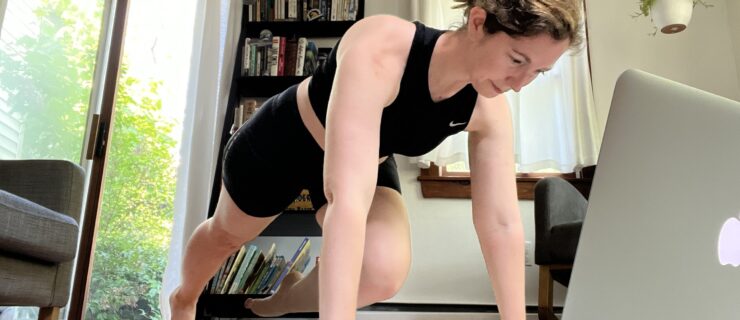Your Best Body: Creams, Lotions and Potions
Every dancer has some tube of pain-relieving gel or cream stashed inside her dance bag. It’s a quick, easy way to soothe sore muscles and achy joints. In fact, the simple act of massaging the products in helps to increase blood flow, which aids healing and relaxes overused muscles, says Craig Westin, orthopedic surgeon at the Chicago Center for Orthopedics at Weiss Memorial Hospital and medical director for The Joffrey Ballet.
But most of us rarely think twice about what we’re rubbing on—we just apply the same stuff that other dancers at the studio use. However, not all topical ointments are created equal. There are significant differences between products and all have slightly different effects.
Cool & Warm
Icy Hot, BENGAY and Tiger Balm fall into the same family: All contain menthol, an organic compound obtained from mint plants. Menthol is a counterirritant, which causes the skin to feel cool and then warm, helping to distract the user from pain in muscles, joints and tendons.
BENGAY and Icy Hot also contain 30 percent methyl salicylate, or wintergreen oil. It’s a pain reliever and a counterirritant with structural properties similar to aspirin: One teaspoon of pure wintergreen oil is equivalent to nearly 22 adult aspirin tablets.
Tiger Balm and Ultra Strength BENGAY cream both include camphor, which is chemically manufactured from turpentine oil. It acts as a slight local anesthetic and increases blood flow to the area, and is also a counterirritant.
Although these cooling/warming creams may feel like they are working deep inside a muscle or tendon, for the most part the effect is really just skin deep. Their main purpose is to mask pain—which could get you in trouble if you’re applying them to ignore a serious injury. “If a dancer finds that these products help muscle aches or sore joints feel a little more comfortable, it’s okay if she uses them,” says Peter Breen, a physical therapist and owner of Backstage PT, a dance, orthopedic and sports physical therapy center in Boston. “But they’re not necessarily something I would recommend.”
A Homeopathic Approach
One of the first things Breen recommends when a dancer complains of minor aches and pains is arnica. This homeopathic remedy is used to soothe muscle aches, reduce inflammation and heal wounds, including bruises and sprains. While there hasn’t been much clinical research on the herb, Westin says that arnica works by causing the blood vessels to dilate, increasing circulation, which helps speed recovery.
Arnica comes from a perennial plant with yellow-orange flowers similar to daisies—the fresh or dried flower heads have been used medicinally since the 1500s. Arnica is generally safe when used topically as a cream, but prolonged use may irritate the skin, causing eczema, peeling, blisters or other skin conditions.
By Prescription Only
One ointment many dancers carry is Voltaren Gel, a topical nonsteroidal anti-inflammatory drug—the equivalent of having ibuprofen (Advil, Motrin) or naproxen (Aleve) in a tube. The active ingredient is diclofenac sodium, which reduces pain and inflammation.
“It is most effective for a tendon irritation in the foot or ankle, for example, because it can better penetrate the skin there than in a large muscle,” Westin says. Voltaren is especially helpful if a dancer has problems taking NSAIDs orally, due to stomach ulcers or kidney sensitivities. Side effects are not that common, but can include skin irritation, allergic reactions, high blood pressure, asthma attacks or stomach pain.
Doubling Up
There are some days when rubbing on an ointment isn’t enough, and you need something more. Don’t worry: It’s safe to take oral anti-inflammatories at the same time as using most over-the-counter gels. “However, if you’re using a topical cream and taking anti-inflammatories daily, then there is something else going on and you need to see a dance medicine specialist,” says Brad R. Moser, director of Minnesota Dance Medicine.
If you have localized pain that lasts more than a few days, stop using non-prescribed products and schedule a doctor’s appointment. “If you don’t know the cause of your pain, whether it’s an injury or an issue with technique, you’re not getting to the root of the problem,” Westin says. “You want to make sure you have a proper diagnosis and you’re not just hiding your pain.”
Back To The Basics
Although tubes of cream are convenient to throw in a dance bag, your best line of defense may actually be ice. “It’s very hard to go wrong with ice,” Breen says. “Ninety-nine percent of the time it is applicable for any type of ailment, and it’s safe and efficient.” Ice constricts blood vessels to help prevent swelling. After 48 hours, switching to heat will help blood circulate to promote healing. Moser also notes that ice is as pure as possible—no synthetic additives to worry about. “It’s as benign as you can get.”
High Arches? Try This
Beautiful feet are both a blessing and a curse: Although we all want high insteps and arches, they come with a greater susceptibility to injuries like strains, sprains and stress fractures. Sigrid Scruggs, founder of Theatre Arts Physiotherapy in Millburn, NJ, recommends dancers with hyper-flexible feet guard against injury by practicing this “doming” exercise. It trains the intrinsic muscles of the feet to pull up evenly on both sides, which helps control and align wobbly ankles.
1. Start by standing on flat. Find your balance on one leg.
2. Without scrunching your toes, pull up the arch of your standing foot until your weight is balanced between your big toe, little toe and heel. The center of your foot should not be touching the floor.
3. Hold for 5 seconds, then switch legs.
4. Repeat 8 to 16 times.
Class, Then Core
Almost every dancer warms up with some sort of abdominal exercise before barre. But if you’re looking to really increase your core strength, consider doing a set of crunches after class, too. Muscles are at their optimal point for strengthening once they’re already warm because that’s when enzyme activity for muscle growth is at its peak. Even though you’re tired, remember that your most effective core workout could come after grand allégro.
The Milky Way
Dozens of drinks out there promise to be the perfect post-exercise fuel. Researchers at the University of Texas at Austin recently set out to determine which were the most effective: carbohydrate sports drinks, zero-calorie drinks or low-fat chocolate milk. The winner? Chocolate milk. Milk drinkers showed improved times while working out, were in better overall shape and their bodies had more muscle and less fat. The natural protein/carb mix offers significant benefits as a refuel tool. Drink up!
Low-Cal Comfort
As coats and scarves come out of storage, so do cravings for comfort food. Don’t worry: You can indulge in fall favorites without packing on “insulation.” Just add veggies. According to a study at Penn State University, people who ate a meal filled with pureed vegetables inadvertently cut their intake by up to 350 calories. The added produce works as a natural appetite suppressant by bulking up dishes with low-cal—and filling—fiber. Researchers suggest adding pureed cauliflower or squash to macaroni and cheese, or baking pumpkin bread loaded with canned pumpkin.
Eat Like A Pro
Looking for a healthy new mid-rehearsal snack? Try this simple recipe for an open-faced avocado egg salad sandwich created by Royal Danish Ballet corps member Shelby Elsbree. “It’s got a lot of protein, healthy omega-3 oils and the perfect amount of carbs to keep you energized and satiated until your next meal!” she says. “It’s the perfect ‘power snack.’ ”
Ingredients:
2 hard-boiled eggs
1/2 an avocado, sliced into cubes
1 teaspoon Dijon or honey mustard
1–2 tablespoons plain yogurt
1–2 finely chopped scallions
A dash of salt and pepper to taste
1 slice multi-grain bread
1. Combine all ingredients (except bread), adding more or less of each until you reach your desired consistency and flavor.
2. Toast the slice of bread and spread homemade egg salad generously on top.





